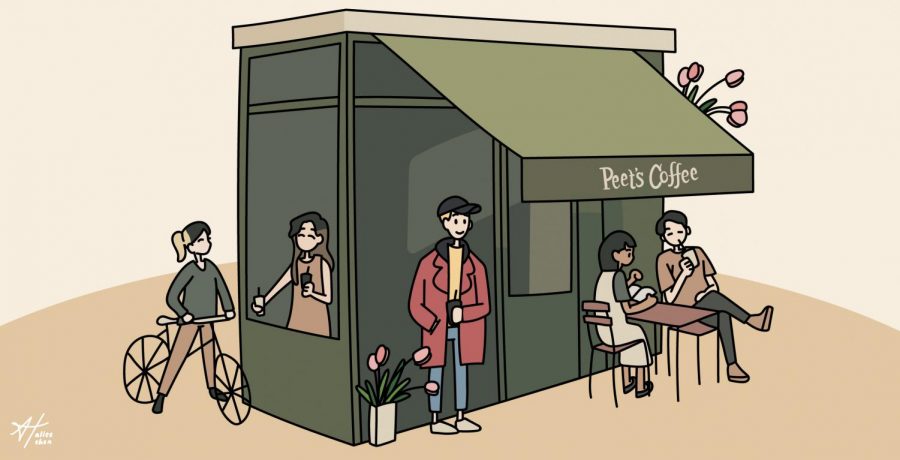An ode to Peet’s: community in a coffee shop
May 29, 2020
Truth be told, I’m somewhat of a coffee addict. You can find me gulping down a latte or a cold brew at just about any hour, just short of every day. This is a defining personality trait of mine.
But even more so might be my adoration for one coffee shop in particular: the Torrey Highlands Peet’s Coffee.
Between the smell of roasted espresso beans that greets me every time I open the front door, the cup of coffee that awaits me at the bar, the sun beams that glisten across the chestnut benches, I grow warm just thinking about an afternoon at Peet’s.
This warmth that I feel when I’m sitting inside Peet’s is more than just the direct sunlight on my skin or the caffeine taking full effect—it’s a feeling of community. I love that sunlight that spreads through the building in the afternoon not because of what it illuminates, but who.
The lowerclassmen are stumbling in, getting hooked on the microdose of caffeine in their first javiva. The upperclassmen are fighting for tables, hunkering down to write papers and apply to college and host club meetings—or to pretend to do any one of those.
And if a table isn’t occupied by a Westview student, a regular or retired teacher has likely already claimed it.
No matter what for, you can find just about anyone at Peet’s. It’s a snapshot of the Westview community. Peet’s, with its variety of people doing a variety of things, is one of the most inspiring and uniting places I do my work in. It’s not home nor school—an environment free of expectations or associations.
According to a study done by Dr. Lisa Waxman, professor of psychology at Florida State University, I’m not alone in this. Researchers found a correlation between length of patronage at a single coffee shop and attachment to their community.
Coffee shop culture has long been known to facilitate a sense of community. Even in the Enlightenment period, the first coffee shops became local gathering spots for thinkers and creators to collaborate.
Waxman attributed part of this to the flexibility of a coffee shop environment. We’re free to study for long periods of time, drop in for a drink, meet up with old and new faces. We can grab chairs from various corners of the shop and pull them around one table.
The space is ours to make of it. For that reason, it brings so many people together, no matter their agenda.
But even with the many who come and go, Peet’s has always been a constant for me. It’s as if time stops when I sit at those tables.
I never realized time was passing until I was met with reminders, and I could most often find these at Peet’s. It was in the seasonal drink menus I’d want to try, the new workers I’d hardly recognize, the rehearsals I was there in between.
Those walls hold memories of the seat I preferred, the coffee I downed, the friends I was surrounded by. I still remember my first trip to Peet’s freshman year, and I’ll never forget my last time sitting there March 13, after that last day of real school.
As I head off to new places in life, I’ll always be sure to remember the Torrey Highlands Peet’s, while making it my mission to find a new Peet’s—even if it isn’t Peet’s itself. It’s not Peet’s to me because of the coffee or the design, but the sense of community, the home that shop has become to me.
In just having this constant community to go to, I’ve even been able to recognize the changes in both time and myself. It’s in the drink I order, the work I do, the frequency in which I go.
But most of all, I see it in who I invite to sit across from me or pull up a chair next to. It’s in the strangers that I began to interact with—an activity I never even thought I’d partake in.
So yes, I am somewhat of a coffee addict. But that’s not the main reason you’ll find me sitting in the corner of the Torrey Highlands (and soon to be Evanston, Illinois Peet’s) on any given day.


